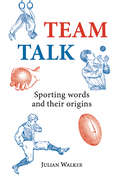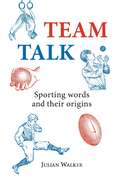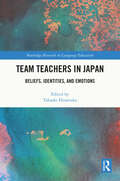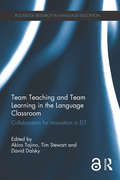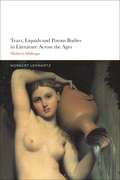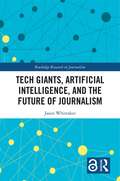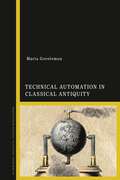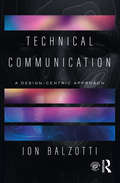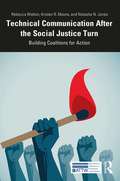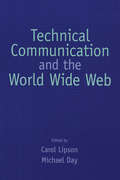- Table View
- List View
Teaching Writing through the Immigrant Story
by Heather Ostman Howard Tinberg Danizete MartínezTeaching Writing through the Immigrant Story explores the intersection between immigration and pedagogy via the narrative form. Embedded in the contexts of both student writing and student reading of literature chapters by scholars from four-year and two-year colleges and universities across the country, this book engages the topic of immigration within writing and literature courses as the site for extending, critiquing, and challenging assumptions about justice and equity while deepening students’ sense of ethics and humanity. Each of the chapters recognizes the prevalence of immigrant students in writing classrooms across the United States—including foreign-born, first- and second-generation Americans, and more—and the myriad opportunities and challenges those students present to their instructors. These contributors have seen the validity in the stories and experiences these students bring to the classroom—evidence of their lifetimes of complex learning in both academic and nonacademic settings. Like thousands of college-level instructors in the United States, they have immigrant stories of their own. The immigrant “narrative” offers a unique framework for knowledge production in which students and teachers may learn from each other, in which the ordinary power dynamic of teacher and students begins to shift, to enable empathy to emerge and to provide space for an authentic kind of pedagogy. By engaging writing and literature teachers within and outside the classroom, Teaching Writing through the Immigrant Story speaks to the immigrant narrative as a viable frame for teaching writing—an opportunity for building and articulating knowledge through academic discourse. The book creates a platform for immigration as a writing and literary theme, a framework for critical thinking, and a foundation for significant social change and advocacy. Contributors: Tuli Chatterji, Katie Daily, Libby Garland, Silvia Giagnoni, Sibylle Gruber, John Havard, Timothy Henderson, Brennan Herring, Lilian Mina, Rachel Pate, Emily Schnee, Elizabeth Stone
Teaching Young Learners in a Superdiverse World: Multimodal Approaches and Perspectives (Routledge Research in Education #190)
by Heather Lotherington Cheryl PaigeThis book documents a collaborative action research project in one school where researchers and practitioners worked together to develop multimodal literacies and pedagogies for diverse, multilingual elementary classrooms. Following chronologically from Lotherington’s Pedagogy of Multiliteracies (2011), this volume picks up after teachers and researchers have learned how to work efficiently as a learning community to offer project-based learning approaches. This edited collection relates how teachers and students of different grade levels, language backgrounds, and abilities developed a shared agenda and created a framework for effective and inclusive practices. Contributors demonstrate that collaboration, creative pedagogical solutions and innovative project-based learning are all essential parts of learning and teaching socially appropriate and responsive literacies in a multimodal, superdiverse world.
Teaching Young Learners in a Superdiverse World: Multimodal Approaches and Perspectives (Routledge Research in Education #190)
by Heather Lotherington Cheryl PaigeThis book documents a collaborative action research project in one school where researchers and practitioners worked together to develop multimodal literacies and pedagogies for diverse, multilingual elementary classrooms. Following chronologically from Lotherington’s Pedagogy of Multiliteracies (2011), this volume picks up after teachers and researchers have learned how to work efficiently as a learning community to offer project-based learning approaches. This edited collection relates how teachers and students of different grade levels, language backgrounds, and abilities developed a shared agenda and created a framework for effective and inclusive practices. Contributors demonstrate that collaboration, creative pedagogical solutions and innovative project-based learning are all essential parts of learning and teaching socially appropriate and responsive literacies in a multimodal, superdiverse world.
Teacup (tactile)
by Markeaton SchoolThis page shows an image of a teacup, a side view at the top and a top view at the bottom of the page. The cups handle sticks out to the right.
Team Talk: Sporting Words and their Origins (Shire General Ser. #2)
by Julian WalkerHave you ever wondered why we talk about a handicap in sport, why boxing is so named, or whether a dumbbell ever rang? It was during the nineteenth century that hitherto local games with relaxed and varying rules were formalized. During this process terminologies developed to refer to these new standardized sports, borrowing, modifying and redefining words from all walks of life in sometimes strange and unexpected ways. Considering such subjects as why sport shares so many words with the fields of hunting and conflict, and how English sports terms have been both adopted from and given to other languages, this book looks at how words have come into the field of sport and how they have developed and changed.
Team Talk: Sporting Words and their Origins
by Julian WalkerHave you ever wondered why we talk about a handicap in sport, why boxing is so named, or whether a dumbbell ever rang? It was during the nineteenth century that hitherto local games with relaxed and varying rules were formalized. During this process terminologies developed to refer to these new standardized sports, borrowing, modifying and redefining words from all walks of life in sometimes strange and unexpected ways. Considering such subjects as why sport shares so many words with the fields of hunting and conflict, and how English sports terms have been both adopted from and given to other languages, this book looks at how words have come into the field of sport and how they have developed and changed.
Team Teachers in Japan: Beliefs, Identities, and Emotions (Routledge Research in Language Education)
by Takaaki HiratsukaThis book provides insights into the professional and personal lives of local language teachers and foreign language teachers who conduct team-taught lessons together. It does this by using the Japanese context as an illustrative example. It re-explores in this context the professional experiences and personal positionings of Japanese teachers of English (JTEs) and foreign assistant language teachers (ALTs), as well as their team-teaching practices in Japan. This edited book is innovative in that 14 original empirical studies offer a comprehensive overview of the day-to-day professional experiences and realities of these team teachers in Japan, with its focus on their cognitive, ideological, and affective components. This is a multifaceted exploration into team teachers in their gestalt—who they are to themselves and in relation to their students, colleagues, community members, and crucially to their teaching partners. This book therefore offers several empirical and practical applications for future endeavors involving team teachers and those who engage with them—including their key stakeholders, such as researchers on them, their teacher educators, local boards of education, governments, and language learners from around the world.
Team Teachers in Japan: Beliefs, Identities, and Emotions (Routledge Research in Language Education)
This book provides insights into the professional and personal lives of local language teachers and foreign language teachers who conduct team-taught lessons together. It does this by using the Japanese context as an illustrative example. It re-explores in this context the professional experiences and personal positionings of Japanese teachers of English (JTEs) and foreign assistant language teachers (ALTs), as well as their team-teaching practices in Japan. This edited book is innovative in that 14 original empirical studies offer a comprehensive overview of the day-to-day professional experiences and realities of these team teachers in Japan, with its focus on their cognitive, ideological, and affective components. This is a multifaceted exploration into team teachers in their gestalt—who they are to themselves and in relation to their students, colleagues, community members, and crucially to their teaching partners. This book therefore offers several empirical and practical applications for future endeavors involving team teachers and those who engage with them—including their key stakeholders, such as researchers on them, their teacher educators, local boards of education, governments, and language learners from around the world.
Team Teaching and Team Learning in the Language Classroom: Collaboration for innovation in ELT (Routledge Research in Language Education)
by Akira Tajino Tim Stewart David DalskyThis book reignites discussion on the importance of collaboration and innovation in language education. The pivotal difference highlighted in this volume is the concept of team learning through collaborative relationships such as team teaching. It explores ways in which team learning happens in ELT environments and what emerges from these explorations is a more robust concept of team learning in language education. Coupled with this deeper understanding, the value of participant research is emphasised by defining the notion of ‘team’ to include all participants in the educational experience. Authors in this volume position practice ahead of theory as they struggle to make sense of the complex phenomena of language teaching and learning. The focus of this book is on the nexus between ELT theory and practice as viewed through the lens of collaboration. The volume aims to add to the current knowledge base in order to bridge the theory-practice gap regarding collaboration for innovation in language classrooms.
Team Teaching and Team Learning in the Language Classroom: Collaboration for innovation in ELT (Routledge Research in Language Education)
by Akira Tajino Tim Stewart David DalskyThis book reignites discussion on the importance of collaboration and innovation in language education. The pivotal difference highlighted in this volume is the concept of team learning through collaborative relationships such as team teaching. It explores ways in which team learning happens in ELT environments and what emerges from these explorations is a more robust concept of team learning in language education. Coupled with this deeper understanding, the value of participant research is emphasised by defining the notion of ‘team’ to include all participants in the educational experience. Authors in this volume position practice ahead of theory as they struggle to make sense of the complex phenomena of language teaching and learning. The focus of this book is on the nexus between ELT theory and practice as viewed through the lens of collaboration. The volume aims to add to the current knowledge base in order to bridge the theory-practice gap regarding collaboration for innovation in language classrooms.
Tears, Liquids and Porous Bodies in Literature Across the Ages: Niobe’s Siblings
by Norbert LennartzTaking in works from writers as diverse as William Shakespeare, William Wordsworth, Charlotte Brontë, John Keats, James Joyce and D.H. Lawrence, this book spans approximately 300 years and unpacks how bodily liquidity, porosity and petrification recur as a pattern and underlie the chequered history of the body and genders in literature.Lennartz examines the precarious relationship between porosity and its opposite – closure, containment and stoniness – and explores literary history as a meandering narrative in which 'female' porosity and 'manly' stoniness clash, showing how different societies and epochs respond to and engage with bodily porosity.This book considers the ways that this relationship is constantly renegotiated and where effusive and 'feminine' genres, such as 'sloppy' letters and streams of consciousness, are pitted against stony and astringent forms of masculinity, like epitaphs, sonnets and the Bildungsroman.
Tears, Liquids and Porous Bodies in Literature Across the Ages: Niobe’s Siblings
by Norbert LennartzTaking in works from writers as diverse as William Shakespeare, William Wordsworth, Charlotte Brontë, John Keats, James Joyce and D.H. Lawrence, this book spans approximately 300 years and unpacks how bodily liquidity, porosity and petrification recur as a pattern and underlie the chequered history of the body and genders in literature.Lennartz examines the precarious relationship between porosity and its opposite – closure, containment and stoniness – and explores literary history as a meandering narrative in which 'female' porosity and 'manly' stoniness clash, showing how different societies and epochs respond to and engage with bodily porosity.This book considers the ways that this relationship is constantly renegotiated and where effusive and 'feminine' genres, such as 'sloppy' letters and streams of consciousness, are pitted against stony and astringent forms of masculinity, like epitaphs, sonnets and the Bildungsroman.
Tech Giants, Artificial Intelligence, and the Future of Journalism (Routledge Research in Journalism)
by Jason Paul WhittakerThis book examines the impact of the "Big Five" technology companies – Apple, Alphabet/Google, Amazon, Facebook and Microsoft – on journalism and the media industries. It looks at the current role of algorithms and artificial intelligence in curating how we consume media and their increasing influence on the production of the news. Exploring the changes that the technology industry and automation have made in the past decade to the production, distribution and consumption of news globally, the book considers what happens to journalism once it is produced and enters the media ecosystems of the internet tech giants – and the impact of social media and AI on such things as fake news in the post-truth age. The audience for this book are students and researchers working in the field of digital media, and journalism studies or media studies more generally. It will also be useful to those who are looking for extended case studies of the role taken by tech giants such as Facebook and Google in the fake news scandal, or the role of Jeff Bezos in transforming The Washington Post. The Open Access version of this book, available at https://doi.org/10.4324/9781351013758, has been made available under a Creative Commons Attribution-Non Commercial-No Derivatives 4.0 license.
Tech Giants, Artificial Intelligence, and the Future of Journalism (Routledge Research in Journalism)
by Jason Paul WhittakerThis book examines the impact of the "Big Five" technology companies – Apple, Alphabet/Google, Amazon, Facebook and Microsoft – on journalism and the media industries. It looks at the current role of algorithms and artificial intelligence in curating how we consume media and their increasing influence on the production of the news. Exploring the changes that the technology industry and automation have made in the past decade to the production, distribution and consumption of news globally, the book considers what happens to journalism once it is produced and enters the media ecosystems of the internet tech giants – and the impact of social media and AI on such things as fake news in the post-truth age. The audience for this book are students and researchers working in the field of digital media, and journalism studies or media studies more generally. It will also be useful to those who are looking for extended case studies of the role taken by tech giants such as Facebook and Google in the fake news scandal, or the role of Jeff Bezos in transforming The Washington Post. The Open Access version of this book, available at https://doi.org/10.4324/9781351013758, has been made available under a Creative Commons Attribution-Non Commercial-No Derivatives 4.0 license.
Tech Terms: What Every Telecommunications and Digital Media Professional Should Know
by Jeff RutenbeckAn avalanche of acronyms, terms-of-art, buzz words, and short-hand phraseology confronts today's busy communications professionals. Now in its 3rd edition, Tech Terms is an invaluable learning tool to help grasp key aspects of the television and video, PC hardware and software markets, multimedia authoring tools, and the exploding wireless Internet and mobile telecomputing worlds. With more than 1000 terms described in four sentences or less, Tech Terms is perfect the perfect desk reference.
Tech Terms: What Every Telecommunications and Digital Media Professional Should Know
by Jeff RutenbeckAn avalanche of acronyms, terms-of-art, buzz words, and short-hand phraseology confronts today's busy communications professionals. Now in its 3rd edition, Tech Terms is an invaluable learning tool to help grasp key aspects of the television and video, PC hardware and software markets, multimedia authoring tools, and the exploding wireless Internet and mobile telecomputing worlds. With more than 1000 terms described in four sentences or less, Tech Terms is perfect the perfect desk reference.
The Techlash and Tech Crisis Communication
by Nirit Weiss-BlattThis book provides an in-depth analysis of the evolution of tech journalism. The emerging tech-backlash is a story of pendulum swings: We are currently in tech-dystopianism after a long period spent in tech-utopianism. Tech companies were used to 'cheerleading' coverage of product launches. This long tech-press honeymoon ended, and was replaced by a new era of mounting criticism focused on tech's negative impact on society. When and why did tech coverage shift? How did tech companies respond to the rise of tech criticism? The book depicts three main eras: Pre-Techlash, Techlash, and Post-Techlash. The reader is taken on a journey from computer magazines, through tech blogs to the upsurge of tech investigative reporting. It illuminates the profound changes in the power dynamics between the media and the tech giants it covers. The interplay between tech journalism and tech PR was underexplored. Through analyses of both tech media and the corporates' crisis responses, this book examines the roots and characteristics of the Techlash, and provides explanations to 'How did we get here?'. Insightful observations by tech journalists and tech public relations professionals are added to the research data, and together - they tell the story of the TECHLASH. It includes theoretical and practical implications for both tech enthusiasts and critics.
The Techlash and Tech Crisis Communication
by Nirit Weiss-BlattThis book provides an in-depth analysis of the evolution of tech journalism. The emerging tech-backlash is a story of pendulum swings: We are currently in tech-dystopianism after a long period spent in tech-utopianism. Tech companies were used to 'cheerleading' coverage of product launches. This long tech-press honeymoon ended, and was replaced by a new era of mounting criticism focused on tech's negative impact on society. When and why did tech coverage shift? How did tech companies respond to the rise of tech criticism? The book depicts three main eras: Pre-Techlash, Techlash, and Post-Techlash. The reader is taken on a journey from computer magazines, through tech blogs to the upsurge of tech investigative reporting. It illuminates the profound changes in the power dynamics between the media and the tech giants it covers. The interplay between tech journalism and tech PR was underexplored. Through analyses of both tech media and the corporates' crisis responses, this book examines the roots and characteristics of the Techlash, and provides explanations to 'How did we get here?'. Insightful observations by tech journalists and tech public relations professionals are added to the research data, and together - they tell the story of the TECHLASH. It includes theoretical and practical implications for both tech enthusiasts and critics.
Technical Automation in Classical Antiquity
by Maria GerolemouTechnical automation – the ability of man-made (or god-made) objects to move and act autonomously – is not just the province of engineering or science fiction. In this book, Maria Gerolemou, by taking as her starting point the close semantic and linguistic relevance of technical automation to natural automatism, demonstrates how ancient literature, performance and engineering were often concerned with the way nature and artifice interacted. Moving across epic, didactic, tragedy, comedy, philosophy and ancient science, this is a brilliant assembly of evidence for the power of 'automatic theatre' in ancient literature. Gerolemou starts with the earliest Greek literature of Homer and Hesiod, where Hephaestus' self-moving artefacts in the Iliad reflect natural forces of motion and the manufactured Pandora becomes an autonomous woman. Her second chapter looks at Greek drama, where technical automation is used to augment and undermine nature not only through staging and costume but also in plot devices where statues come to life and humans behave as automatic devices. In the third chapter, Gerolemou considers how the philosophers of the 4th century BCE and the engineers of the Hellenistic period with their mechanical devices contributed to a growing dialogue around technical automation and how it could help its audience glance and marvel at the hidden mechanisms of self-motion. Finally, the book explores the ways technical automation is employed as an ekphrastic technique in late antiquity and early Byzantium.
Technical Automation in Classical Antiquity
by Maria GerolemouTechnical automation – the ability of man-made (or god-made) objects to move and act autonomously – is not just the province of engineering or science fiction. In this book, Maria Gerolemou, by taking as her starting point the close semantic and linguistic relevance of technical automation to natural automatism, demonstrates how ancient literature, performance and engineering were often concerned with the way nature and artifice interacted. Moving across epic, didactic, tragedy, comedy, philosophy and ancient science, this is a brilliant assembly of evidence for the power of 'automatic theatre' in ancient literature. Gerolemou starts with the earliest Greek literature of Homer and Hesiod, where Hephaestus' self-moving artefacts in the Iliad reflect natural forces of motion and the manufactured Pandora becomes an autonomous woman. Her second chapter looks at Greek drama, where technical automation is used to augment and undermine nature not only through staging and costume but also in plot devices where statues come to life and humans behave as automatic devices. In the third chapter, Gerolemou considers how the philosophers of the 4th century BCE and the engineers of the Hellenistic period with their mechanical devices contributed to a growing dialogue around technical automation and how it could help its audience glance and marvel at the hidden mechanisms of self-motion. Finally, the book explores the ways technical automation is employed as an ekphrastic technique in late antiquity and early Byzantium.
Technical Communication: A Design-Centric Approach
by Jon BalzottiTechnical Communication: A Design-Centric Approach is a comprehensive textbook for introductory courses in technical communication and professional writing. Technical Communication takes a design approach to foundational and emergent technical communication skills such as document design, job applications and interviews, workplace collaboration, and report writing, providing students with practical guidance on matters of ethics, style, and problem-solving in a range of professional and organizational contexts. This is a core textbook suitable for undergraduate courses in technical and professional communication.The book is supplemented by an innovative website featuring interactive simulations of various real-world technical communication challenges. Visit https://microcore.byu.edu/
Technical Communication: A Design-Centric Approach
by Jon BalzottiTechnical Communication: A Design-Centric Approach is a comprehensive textbook for introductory courses in technical communication and professional writing. Technical Communication takes a design approach to foundational and emergent technical communication skills such as document design, job applications and interviews, workplace collaboration, and report writing, providing students with practical guidance on matters of ethics, style, and problem-solving in a range of professional and organizational contexts. This is a core textbook suitable for undergraduate courses in technical and professional communication.The book is supplemented by an innovative website featuring interactive simulations of various real-world technical communication challenges. Visit https://microcore.byu.edu/
Technical Communication After the Social Justice Turn: Building Coalitions for Action (ATTW Series in Technical and Professional Communication)
by Rebecca Walton Kristen Moore Natasha JonesThis is the first scholarly monograph marking the social justice turn in technical and professional communication (TPC). Social justice often draws attention to structural oppression, but to enact social justice as technical communicators, first, we must be able to trace daily practice to the oppressive structures it professionalizes, codifies, and normalizes. Technical Communication After the Social Justice Turn moves readers from conceptual explorations of oppression and justice to a theoretical framework that allows for the concepts to be applied and implemented in a variety of practical contexts. It historicizes the recent social justice turn in TPC scholarship, models a social justice approach to building theories and heuristics, and presents scenarios that illustrate how to develop sustainable practices of activism and social justice. Its commitment to coalition building, inclusivity, and socially just practices of citation and activism will support scholars, teachers, and practitioners not only in understanding how the work of technical communication is often complicit in oppression but also in recognizing, revealing, rejecting, and replacing oppressive practices.
Technical Communication After the Social Justice Turn: Building Coalitions for Action (ATTW Series in Technical and Professional Communication)
by Rebecca Walton Kristen Moore Natasha JonesThis is the first scholarly monograph marking the social justice turn in technical and professional communication (TPC). Social justice often draws attention to structural oppression, but to enact social justice as technical communicators, first, we must be able to trace daily practice to the oppressive structures it professionalizes, codifies, and normalizes. Technical Communication After the Social Justice Turn moves readers from conceptual explorations of oppression and justice to a theoretical framework that allows for the concepts to be applied and implemented in a variety of practical contexts. It historicizes the recent social justice turn in TPC scholarship, models a social justice approach to building theories and heuristics, and presents scenarios that illustrate how to develop sustainable practices of activism and social justice. Its commitment to coalition building, inclusivity, and socially just practices of citation and activism will support scholars, teachers, and practitioners not only in understanding how the work of technical communication is often complicit in oppression but also in recognizing, revealing, rejecting, and replacing oppressive practices.
Technical Communication and the World Wide Web
by Carol Lipson Michael DayOver the past decade, the World Wide Web has dramatically changed the face of technical communication, but the teaching of writing has thus far altered very little to accommodate this rapidly changing context. Technical Communication and the World Wide Web offers substantial and broadly applicable strategies for teaching global communication issues affecting writing for the World Wide Web.Editors Carol Lipson and Michael Day have brought together an exceptional group of experienced and well-known teacher-scholars to develop this unique volume addressing technical communication education. The chapters here focus specifically on curriculum issues and the teaching of technical writing for the World Wide Web, contributing a blend of theory and practice in proposing changes in curriculum and pedagogy. Contributors offer classroom examples that teachers at all levels of experience can adapt for their own classes. The volume provides comprehensive coverage of the technical communication curriculum, from the two-year level to the graduate level; from service courses to degree programs.This volume is an important and indispensable resource for technical writing educators, and it will serve as an essential reference for curriculum and pedagogy development in technical communication programs.



